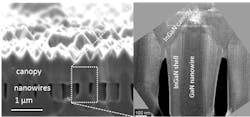Sandia creates InGaN nanowires for wide-spectrum solar cells
| Cross-sectional images of the InGaN nanowire photovoltaic cell. (Image: Sandia National Laboratories) |
Albuquerque, NM--Sandia National Laboratories scientists Jonathan Wierer Jr. and George Wang have grown indium gallium nitride (InGaN) nanowires for photovoltaic cells that could lead to the optical-to-electrical conversion of a higher portion of the visible solar spectrum. The nanowire structure allows a boost in the proportion of indium, which shifts the bandgap to shorter wavelengths, and yet avoids the mechanical strain that can result from a high proportion of indium in conventional flat InGaN designs.
The researchers reported in the journal Nanotechnology that if the indium mixture is grown on a phalanx of nanowires rather than on a flat surface, the small surface areas of the nanowires allow the indium shell layer to partially relax along each wire. This relaxation allowed the team to create a nanowire solar cell with indium percentages of roughly 33%, higher than any other reported attempt at creating III-nitride solar cells.
This initial attempt also lowered the absorption base energy from 2.4 eV to 2.1 eV, the lowest of any III-nitride solar cell to date, and made a wider range of wavelengths available for power conversion. Power conversion efficiencies were low -- only 0.3% compared to a standard commercial cell that hums along at about 15% -- but the demonstration took place on imperfect nanowire-array templates. Refinements should lead to higher efficiencies and even lower energies.
Several techniques were used to create the III-nitride nanowire array solar cell. A top-down fabrication process was used to create the nanowire array by masking a GaN layer with a colloidal silica mask, followed by dry and wet etching. The resulting array consisted of nanowires with vertical sidewalls of uniform height.
Next, shell layers containing the higher indium percentage of InGaN were formed on the GaN nanowire template via metal-organic chemical vapor deposition. Lastly, In0.02Ga0.98N was grown in such a way that caused the nanowires to coalesce. This process produced a canopy layer at the top, facilitating simple planar processing and making the technology manufacturable.
The results, says Wierer, although modest, represent a promising path forward for III-nitride solar cell research. The nanoarchitecture not only enables higher indium proportion in the InGaN layers but also increased absorption via light scattering in the faceted InGaN canopy layer, as well as air voids that guide light within the nanowire array.
The research was funded by DOE's Office of Science through the Solid State Lighting Science Energy Frontier Research Center, and Sandia's Laboratory Directed Research and Development program.
